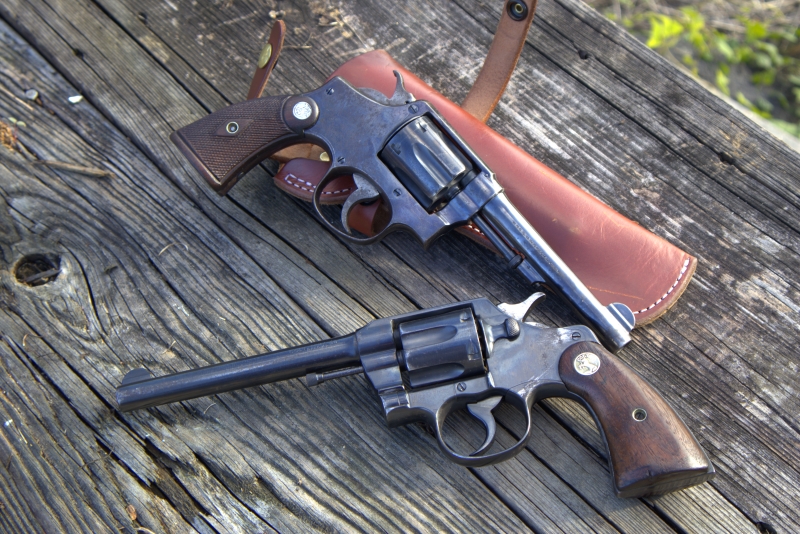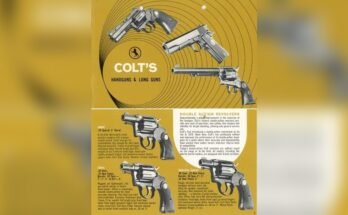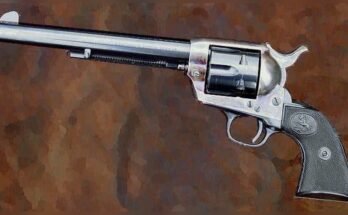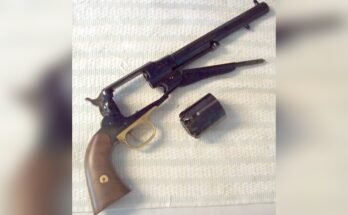Have you ever wondered if swing-out cylinder revolvers are still used by law enforcement today? You might think these classic guns belong only in old movies or history books.
But the truth could surprise you. Understanding whether these revolvers are part of modern police gear can change how you see law enforcement tools—and even your own safety. Keep reading to uncover the real role swing-out cylinder revolvers play in today’s law enforcement and why it matters to you.

History Of Swing-out Cylinder Revolvers
The swing-out cylinder revolver changed how guns were used and reloaded. This design allows the cylinder to swing out from the frame. It makes reloading faster and easier. This feature improved the revolver’s practicality for many users.
These revolvers became popular in the late 19th century. They offered a new way to load and unload cartridges. The design also made cleaning the gun simpler. This helped in keeping the revolver reliable over time.
Development And Design
The swing-out cylinder design appeared in the 1870s. It replaced earlier models that used fixed cylinders. Fixed cylinders required removing each cartridge one by one. The new design allowed all chambers to be accessed at once.
This change sped up the reloading process. The cylinder swings out on a hinge, usually on the left side. This lets users eject all spent cartridges quickly. They can then load fresh cartridges into the chambers.
The design became popular due to its ease of use. It also improved safety by reducing the chance of misfires. This innovation set the standard for many revolvers that followed.
Early Law Enforcement Adoption
Law enforcement agencies began using swing-out cylinder revolvers in the late 1800s. Officers needed reliable and quick-firing weapons. The new revolvers met these needs well.
Agencies favored the easy reload feature. Officers could reload faster during critical moments. This advantage helped improve their response in dangerous situations.
Soon, many police departments replaced older revolvers. Swing-out cylinder models became the standard sidearm. Their durability and speed made them trusted tools for law enforcement.
Features Of Swing-out Cylinder Revolvers
Swing-out cylinder revolvers have distinct features that set them apart. They offer a practical design that makes loading and unloading faster. These revolvers are popular for their ease of use and reliability. Understanding their key features helps explain their role in law enforcement.
Their design allows quick access to all chambers of the cylinder. This feature is important for efficient reloading during critical moments. Their durability and simple mechanics make them a trusted choice.
Mechanics And Operation
Swing-out cylinder revolvers have a cylinder that swings out to the side. This exposes all chambers for loading or unloading cartridges. The cylinder locks firmly in place when closed. This ensures the revolver fires safely and accurately.
The action is smooth, allowing shooters to reload quickly. Most models use a single or double-action trigger. This means the shooter can fire with a simple pull or cock the hammer first. The design reduces jamming and mechanical problems.
Advantages Over Other Revolvers
Swing-out cylinders speed up the reloading process significantly. Other revolvers may require removing the cylinder or loading each chamber individually. This can take extra time during urgent use.
The solid frame offers strength and stability. This improves accuracy and reduces wear over time. These revolvers also handle a wider range of ammunition types safely. Their balance and weight make them comfortable to hold and shoot.
Swing-out Cylinder Revolvers In Modern Policing
Swing-out cylinder revolvers once played a major role in law enforcement. These firearms allowed quick reloading by swinging the cylinder out to the side. Over time, police departments have shifted toward other types of handguns. Still, some officers appreciate the reliability and simplicity of swing-out revolvers.
This section explores how modern police forces use these revolvers today. It also explains why their popularity has dropped in recent years. Understanding these points helps clarify the role of swing-out cylinder revolvers in current law enforcement.
Current Usage Trends
Many police officers now prefer semi-automatic pistols. These guns hold more bullets and reload faster than revolvers. Yet, some departments keep swing-out cylinder revolvers as backup weapons. They are valued for their strong mechanical design and fewer moving parts.
In rural areas or smaller forces, revolvers remain common. Their ease of use suits officers who train less often. Also, revolvers function well in harsh conditions without jamming. This reliability keeps them in service despite newer options.
Reasons For Decline In Popularity
Semi-automatic pistols offer higher ammunition capacity than revolvers. This advantage is critical during extended incidents. Revolvers usually hold six rounds, while pistols can carry 15 or more. Reloading a revolver takes more time and effort.
Advances in pistol technology improved accuracy and ease of use. Police forces prefer firearms that combine power with quick operation. Training also focuses on semi-automatic handguns. This shift reduces the need for revolver skills.
Another factor is the tactical gear officers wear. Duty belts and holsters are designed mainly for pistols. Revolvers can be bulkier and less convenient to carry. These practical reasons contribute to the decline in revolver use.
Comparing Revolvers And Semi-automatic Pistols
Revolvers and semi-automatic pistols serve as two main types of handguns. Each has unique features that affect their use in law enforcement. Understanding their differences helps explain why one might be chosen over the other by police officers. This section compares key aspects of revolvers and semi-automatic pistols.
Firepower And Capacity
Revolvers typically hold six rounds in a cylinder. Semi-automatic pistols often carry 10 to 15 rounds in a magazine. More rounds mean fewer reloads during critical moments. Semi-automatics offer greater firepower in a smaller size. Revolvers have simpler mechanics but lower capacity. This limits the number of shots before reloading.
Reloading Speed And Efficiency
Reloading a swing-out cylinder revolver takes longer. The user must open the cylinder and insert rounds individually or with a speed loader. Semi-automatic pistols allow faster reloads by swapping magazines. Quick magazine changes save valuable seconds in urgent situations. This speed benefits officers in active confrontations. Revolvers can slow down the user during high-pressure moments.
Reliability And Maintenance
Revolvers have fewer moving parts and are less likely to jam. Their simple design makes them reliable in tough conditions. Semi-automatic pistols require regular cleaning to avoid malfunctions. Dirt or debris can cause jams in semi-automatics. Revolvers are easier to maintain and operate under stress. This reliability appeals to officers needing a dependable firearm.
Shocking Truths About Their Law Enforcement Role
Swing-out cylinder revolvers have a rich history. Many believe they were standard in police forces. The reality tells a different story. These revolvers played a smaller role than most expect.
Law enforcement agencies favored other handguns. Semi-automatic pistols gained popularity for faster reloads. The swing-out cylinder revolvers were often seen as outdated by the late 20th century.
Still, some departments used them for years. Their reliability and simplicity made them attractive. Yet, their presence in active duty was limited and often replaced quickly.
Myths Vs. Reality
Many assume all revolvers used by police had swing-out cylinders. In truth, some early models used top-break or fixed-cylinder designs. Swing-out cylinders became popular but only for a brief period.
Movies and TV shows often exaggerate their use. They show officers with revolvers in every hand. The truth is fewer officers carried them in real life. Departments switched to semi-automatics for better firepower and faster reloading.
Notable Cases And Incidents
Some famous police incidents featured swing-out cylinder revolvers. These cases helped shape their reputation. For example, early 1900s law enforcement officers used them in key shootouts.
Over time, as crime tactics changed, so did weapon choices. These revolvers became less common in major incidents. Still, their role in historical law enforcement remains significant.

Future Of Swing-out Cylinder Revolvers In Law Enforcement
The future of swing-out cylinder revolvers in law enforcement is uncertain but interesting. These revolvers have a long history of use, but modern needs challenge their role. Officers require fast reloading, high capacity, and lightweight firearms. Swing-out cylinder revolvers often fall short in these areas. Yet, they still have qualities that may keep them relevant.
Technological Innovations
New materials make revolvers lighter and stronger. Advances in ammunition improve stopping power and reduce recoil. Some manufacturers add improved sight systems for better accuracy. There are designs that speed up cylinder rotation and reloading. These changes help revolvers compete with semi-automatic pistols. Technology may revive interest in swing-out cylinder revolvers for law enforcement.
Potential Niche Roles
Revolvers may fit specific law enforcement roles better. They can serve as backup weapons for officers. Their simplicity means fewer malfunctions under stress. Some units may prefer revolvers for quiet operations. Swing-out cylinder revolvers also suit rural or reserve officers. These niche roles keep revolvers useful despite new trends.

Frequently Asked Questions
Are Swing-out Cylinder Revolvers Common In Law Enforcement?
Swing-out cylinder revolvers are less common today in law enforcement. Most agencies prefer semi-automatic pistols for higher capacity and faster reloads. However, some officers still use revolvers for backup or specific duties due to their reliability and simplicity.
Why Do Some Police Officers Still Carry Revolvers?
Some officers carry revolvers for their durability and ease of use. Revolvers have fewer moving parts, making them less prone to malfunctions. They are also favored for backup weapons or in situations requiring a reliable, straightforward firearm.
How Do Swing-out Cylinder Revolvers Compare To Semi-automatics?
Swing-out cylinder revolvers offer simplicity and reliability but have lower ammunition capacity. Semi-automatic pistols provide faster reloading and higher magazine capacity. Law enforcement generally prefers semi-automatics for tactical advantages, but revolvers remain valued for specific roles.
What Advantages Do Swing-out Cylinder Revolvers Offer Law Enforcement?
Revolvers provide excellent reliability and easy maintenance. Their simple design reduces jamming risks. They are also user-friendly for officers with limited firearms training, making them useful as backup weapons or in specialized law enforcement roles.
Conclusion
Swing-out cylinder revolvers are not common in modern law enforcement. Most officers prefer semi-automatic pistols for faster reloading and higher capacity. Revolvers are simple and reliable but slower to reload. They still have a place in some backup roles or special situations.
Choosing a firearm depends on many factors like training, mission, and personal comfort. Understanding these differences helps explain why swing-out cylinder revolvers are rare in police work today. The focus remains on efficiency and readiness in law enforcement gear.



